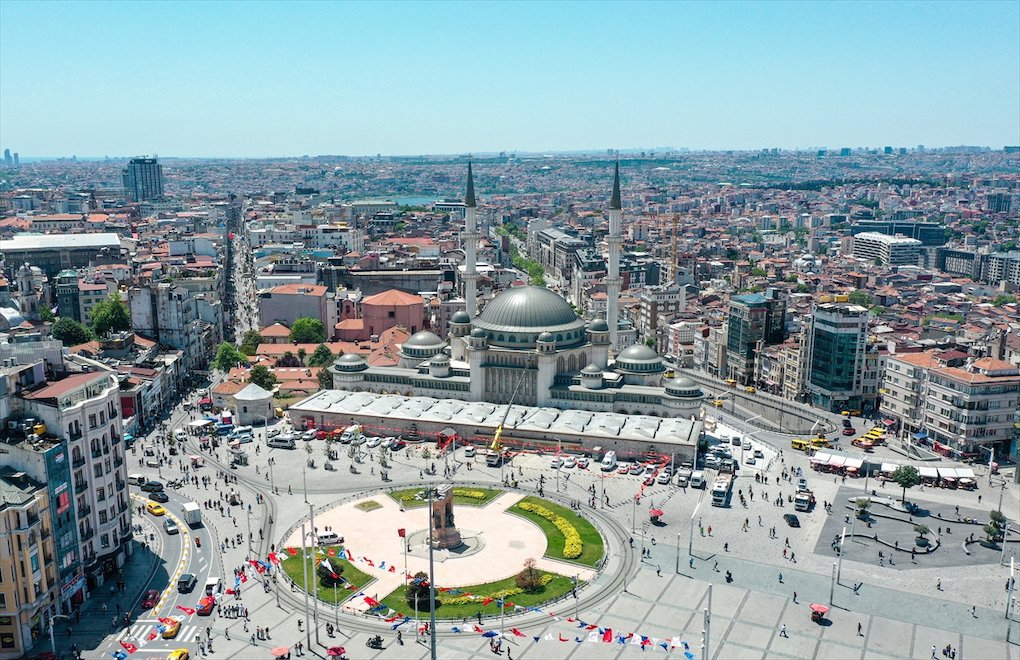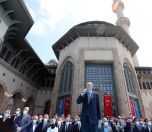* Photos: Anadolu Agency (AA)
Click to read the article in Turkish
Taksim Mosque was opened with a ceremony attended by President and ruling Justice and Development Party (AKP) Chair Recep Tayyip Erdoğan last Friday, on May 28, 2021.
The mosque, which has been Erdoğan's "favorite project" since he was the Mayor of İstanbul, was built on a much larger area than it was originally planned during his term in office as the prime minister.
The area of the mosque, which was built with nine floors, five of which are underground, is close to 17,000 square meters.
It is stated that 2,250 people can pray at the same time in the mosque, which has 12 domes and two minarets, one of which is 30 meters high. The mosque also has a parking lot for 600 cars.
Erdoğan's story began in 1994
When Erdoğan announced his candidacy for the İstanbul Mayor's office from the Welfare Party (RP) for the March 1994 local elections, when his name was becoming more and more popular, he showed the square to the cameras from the roof of a building in Taksim and said:
"This is the area that was thought for the Taksim Mosque 20 years ago, this is an idea based on years ago. I hope we will have the opportunity to lay the foundation of this place."
In the same year, after he became the Mayor of İstanbul Metropolitan Municipality (İMM), when he appeared on Reha Muhtar's program on the state channel TRT, he reacted to Muhtar's question, "Why are you bringing Taksim Mosque to the agenda instead of İstanbul's infrastructure problems?" by answering, "First of all, I do not speak about Taksim Mosque as much as you do, but the press does. There is an established foundation. The association made its offer, the metropolitan municipality took over the project, I'm not devoting any time to it. Otherwise, Taksim Mosque is not a topic that is attributed to me now."
Then, he made the statement that caused the debate to grow once again: "I'm in favor of it. I do not allocate money for it, the citizens will."
Twenty years after these debates flared up with Erdoğan's words, Erdoğan was elected Turkey's 12th President and Taksim Mosque was once again on the agenda.
Erdoğan started the project, which he wasn't able to due to judicial decisions while he was the mayor, during the debates about Taksim Square and Gezi Park during his Presidency. Construction of the mosque began in February 2017, ahead of the constitutional amendment referendum.
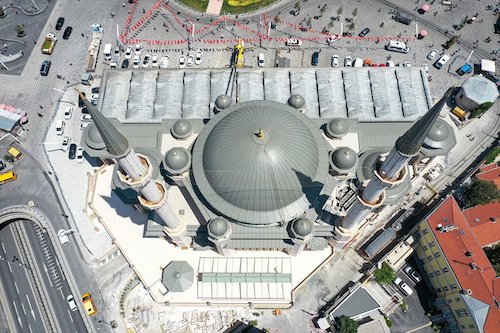
The first time it appeared on the agenda
In addition to the Orthodox Church built in the late 1800s in Taksim, there was a mosque inside the Topçu Barracks. However, this mosque became unusable in the early 20th century, after which the barracks were completely destroyed in 1940.
After that date, the construction of a mosque in Taksim Square came to the fore from time to time.
The period when it was seriously dealt with for the first time was the Democrat Party (DP) rule, which came to power after the single-party period. Seeing renovating mosques or building mosques from scratch in symbolic places as an indicator of his political power, Prime Minister Adnan Menderes brought up giving Hagia Sophia the status of a mosque again in 1952.
In 1955, he allocated a smaller parcel of land in Taksim Square, where the mosque is built today, to the municipality for the construction of a mosque. In 1956, the "Association for Building the Taksim Mosque" was founded, of which some business people and politicians were a part.
In other words, these discussions date back to almost 70 years ago.
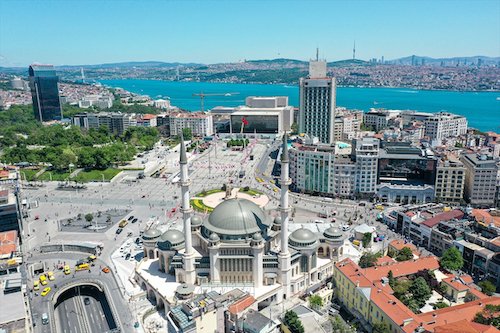
The Justice Party, led by Süleyman Demirel, which came to power shortly after the coup on May 27, 1960, took a similar step in 1965.
The Council of Ministers at that time decided to sell the Agricultural (Ziraat) Bank and Treasury land in the region where the mosque was planned to the Directorate General of Foundations.
However, this step was not a serious agenda item until the local elections in 1968, when the Republican People's Party's (CHP) İstanbul Municipality was taken to court and the land allocation was stopped. The mosque project, which was at the center of many discussions during the local elections, was shelved for a while after the election.
In 1977, during the second Nationalist Front Government under Süleyman Demirel's prime ministry, the Beyoğlu District Development Plan was changed.
This land, which was seen as a parking lot in the new plan, was allocated for the mosque. The Ministry of Culture also received approval from the High Council of Monuments. However, one of the property owners, İstanbul Municipality, was still with the CHP and the municipality did not agree to sell its land for the construction of a mosque.
In the same year, another development was taking place in Taksim Square. The repair of the building called İstanbul Cultural Palace, which was opened in 1969 for the performances of the State Opera and Ballet and the State Theaters, became unusable a year later due to a major fire and was under renovation until 1977.
The building, which was reopened for use in 1978, was named Atatürk Cultural Center (AKM).
In 1980, Demirel passed another Council of Ministers' decision, this time to restore the allocation of Ziraat Bank land, which was canceled in 1965.
After ten days the Taksim Mosque Sherifi Complex Enforcement and Survival Association, which was established to enlarge the masjid in the square to build a mosque, started to talk about the construction's beginning with the officials, the September 12 coup took place. The plans of the Nationalist Front were once again stalled.
1983 State Council decision
After the coup, the Mayor of İstanbul, General İsmail Hakkı Akansel, canceled the development plan in 1977 and re-designated the area allocated for the mosque as a parking lot.
And the objections went to the Council of State in 1983. On February 7, 1983, the 6th Chamber of the State Council decided that the "Taksim Mosque project is not suitable in terms of city planning principles and public interest."
Taksim Mosque Culture and Art Foundation was established in 1992, approximately 10 years later, that is, sometime after the coup period ended and elections began to be held.
The proposal Erdoğan mentioned in his interview with Reha Muhtar during his mayorship was also made by this foundation.
Erdoğan's words "We will give permission for a mosque in Taksim and President Demirel will lay its foundation" brought up the discussions on the subject again.
While the Prime Minister of the time, Necmettin Erbakan, announced that they would "lay the foundation soon", the then İstanbul Governor Hayri Kozakçıoğlu made a statement that "as the civil authority, he would not allow the mosque."
In 1995, the Conservation Board declared that the area planned to be allocated for the construction of a mosque, appearing as a parking lot in the municipal plans, contained "remains of historical water structures and brick tombs" and declared the area as a protected area (SİT).
However, Beyoğlu's Mayor of the time, Nusret Bayraktar, announced in 1996 that "the construction of the mosque, whose foundation would be laid by Prime Minister Erbakan, would begin."
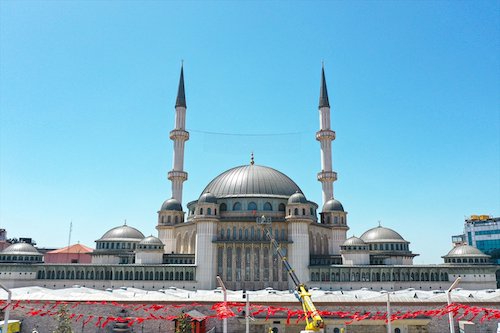
The Taksim Mosque project, which was one of Erdoğan's favorite projects and was frequently brought to the agenda during his mayorship, was also of great symbolic importance as it was a project that has been planned by the right-wing governments for decades, but postponed.
For the mosque project, which was on the agenda of "secularism debates" at that time, İsmail Kahraman, Minister of Culture from the Welfare Party (RP), said that "those who opposeed the mosque in Taksim were bigots." Kahraman became an AKP MP years later and served as the Speaker of the Grand National Assembly of Turkey (TBMM) between 2015-2018.
At that time, the news that the foundation of the mosque would be laid on May 29, on the anniversary of the conquest of İstanbul in 1453, was reflected in the press.
Erdoğan's plans to build a mosque instead of Gezi Park during his mayorship or in the place where the mosque is built today, which he pointed out at the election campaign, were once again shelved during the February 28 process.
Artillery Barracks and Taksim Mosque projects
Arrangements regarding Taksim Square were among AKP's top priorities. In 2008, the use of the Atatürk Cultural Center was terminated on the grounds that it had "fulfilled its historical life."
The mosque issue came to the fore again years later, in the eighth year of Erdoğan's prime ministry, at a time when his power was getting stronger.
He announced that he would take another step for the mosque project in Taksim before the 2011 general elections. A year later, a project "which he thought secularists would also like" was drawn up by architect Ahmet Vefik Alp, who was close to the Nationalist Movement Party (MHP).
On another anniversary of the conquest of İstanbul years later, on May 29, 2012, Erdoğan announced that a mosque would be built on Çamlıca Hill. At the same time, the construction of the Mimar Sinan Mosque had also started in Ataşehir.
Speaking to Hürriyet newspaper in 2012, architect Alp announced that "Prime Minister Erdoğan had found the first project too modern and he had revised it and put it on Erdoğan's desk again."
While waiting for the mosque project, Erdoğan had another plan regarding Taksim Square. It was decided to rebuild the Artillery Barracks instead of Gezi Park. Protests began in May 2013 when construction equipment entered Gezi Park for the construction of the revised Artillery Barracks.
The protests, which lasted a few months and are known as the "Gezi Park protests", spread all over Turkey.
The protests ended with the violent intervention of the police, with dozens of injuries, nine deaths, and dozens of others detained. Afterward, Erdoğan took action again, if not for the Artillery Barracks, but for the Taksim Mosque.
At the end of 2016, the mosque project designed by Şefik Birkiye and Selim Dalaman was submitted to the İstanbul No.2 Regional Board for the Preservation of Cultural Heritage. On January 19, 2017, the project was accepted by the board with the block section parcel number. The construction of Taksim Mosque thus began with the organization of Beyoğlu Municipality, Ziraat Bank, and the Directorate General of Foundations.
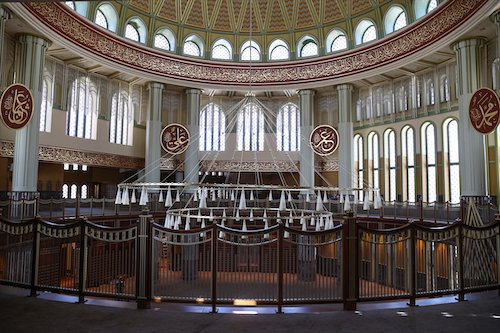
Adnan Ertem, the head of the Directorate General of Foundations, which undertook the control, supervision, and execution of the construction in 2017, explained that they had signed a protocol with Sur Yapı after the decision of the conservation board and why they did not take bids with the following words:
"Sur Yapı, in its own words, undertook this job 'for the sake of Allah.' The owner of Sur Yapı, who was born and raised in Beyoğlu, has dreamed of this since his childhood. That's why he aspires to build the mosque and we signed this protocol."
Stating that the mosque is planned to be put into service on Ramadan in 2018 at the first stage, Ertem said, "Sur Yapı is also very excited, I guess it will make it to that date."
After a while, the demolition of AKM started in February 2018. A new one is still being built in place of the completely demolished building. The new building is planned to be put into use by the end of 2021.
About the mosque
The mosque has a land area of 2,482 square meters and a construction area of approximately 16,000 square meters. It has an area of 2,950 square meters where prayers can be performed with a closed parking lot for 163 vehicles.
The number of people who can pray in the mosque, where 3,000 people can pray at the same time, is 2,400 in the outer courtyard. In the mosque, where 465 square meters are reserved for women, 620 women can pray together. The total indoor and outdoor prayer capacity of the mosque is 4,000 people.
The titanium-zinc alloy used in the dome coatings of the project was specially brought in. In the project, 3,000 square meters of the titanium-zinc alloy were used to cover the dome and roof, while the marbles used on the facades consisted of Emperador Light stones selected from Bursa quarries and Aero Cream stones selected from Antalya Demre quarries.
The mihrab, minbar, and lectern design of the mosque, in which the "naht" technique is used in its interior decorations and calligraphy applications, was designed by Architect Altan Elmas himself as a modern interpretation of the traditional form. In the design of the mihrab, Esmaü'l Hüsna was written by the calligrapher Davut Bektaş with "stowed writing."
While 50,500 cubic meters of excavation and 20,500 cubic meters of reinforced concrete were used in the project, 3,000 tons of reinforced concrete steel were used. 7,500 meters of bored piles, 310 tons of structural steel fabrications, 8,000 square meters of facade stone coating, and 1,300 square meters of facade precast installation were also made.
Taksim Mosque consists of a total construction area of 2,482.46 square meters, a dome height of 33 meters, a minaret of 64.80 meters with two "şerefe"s, a parking area of 10,000 square meters, a prayer area for 4,000 people, a hall of 1,800 square meters in the basement and ground floors, an exhibition hall, a library, and a soup kitchen. (TP/DCE/SD)
* Sources: BBC Türkçe, Anadolu Ajansı (AA)




